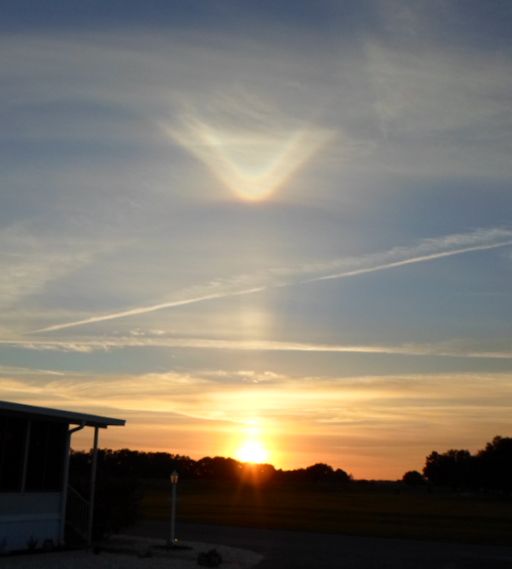MOSTLY QUIET: With no sunspots actively flaring, the Earthside of the sun is quiet. However, two sunspots (AR1908 and AR1909) have 'beta-gamma' magnetic fields that harbor energy for moderately strong eruptions. NOAA forecasters estimate a 25% chance of M-class solar flares on Dec. 3rd. Solar flare alerts: text, voice
RARE V-SHAPED SUN HALO: At the end of Thanksgiving Day when the sun was setting over Sumterville, Florida, Paula Phillips took a break from her meal, stepped outside and saw something odd--a pair of luminous 'Vs' in the deepening twilight:
"I've never seen anything like this before," says Phillips. "I photographed the phenomenon with a simple small Samsung camera."
They're sun halos, caused by sunlight shining through ice crystals. Atmospheric optics expert Les Cowley explains:
"These two ‘V’ shaped halos, one rare and one common, change shape dramatically as the sun climbs," he says. "Near sunrise or sunset is the only time to catch them like this. The lower ‘V’ is an upper tangent arc from horizontal hexagonal prisms of ice. The upper one is a rare sunvex Parry arc from similar crystals that - strangely – are fixed so that two prism faces are always horizontal. In the full-sized image, we also see just a trace of a 22o halo and stretching upwards from the sun a sun pillar."
"I find it odd that I saw this in Florida!" continues Phillips. Yet Florida has ice crystal, too. The atmosphere 5 to 10 km above the Sunshine State is always cold enough for water to freeze.
"Florida and other warm places get plenty of halos--some of them exceedingly rare," says Cowley. "Look for them everywhere, winter and summer."

Solar wind
speed: 383.2 km/sec
density: 5.3 protons/cm3
explanation | more data
Updated: Today at 2225 UT
X-ray Solar Flares
6-hr max: B9 2107 UT Dec03
24-hr: C1 1528 UT Dec03
explanation | more data
Updated: Today at: 2200 UT
![]()
Daily Sun: 03 Dec 13
Sunspots AR1908 and AR1909 have 'beta-gamma' magnetic fields that harbor energy for M-class solar flares. Credit: SDO/HMI
![]()
Sunspot number: 124
What is the sunspot number?
Updated 03 Dec 2013
Spotless Days
Current Stretch: 0 days
2013 total: 0 days (0%)
2012 total: 0 days (0%)
2011 total: 2 days (<1%)
2010 total: 51 days (14%)
2009 total: 260 days (71%)
Since 2004: 821 days
Typical Solar Min: 486 days
Update 03 Dec 2013
The Radio Sun
10.7 cm flux: 134 sfu
explanation | more data
Updated 03 Dec 2013
![]()
Current Auroral Oval:
Switch to: Europe, USA, New Zealand, Antarctica
Credit: NOAA/POES
![]()
Planetary K-index
Now: Kp= 2 quiet
24-hr max: Kp= 3 quiet
explanation | more data
Interplanetary Mag. Field
Btotal: 4.9 nT
Bz: 1.3 nT south
explanation | more data
Updated: Today at 2226 UT
![]()
Coronal Holes: 03 Dec 13
A stream of solar wind flowing from the indicated coronal hole should reach Earth on Dec. 7-8. Credit: SDO/AIA.






Comments
CHEMTRAILS
Yes, it is beautiful. I guess this is the positive side of the Chemtrails! You can see the chemtrails on the photo of the V shaped light. WIth all the metals and chemicals hanging in the air, the chemtrails are creating all sorts of new visual phenomena in the skies. Personally, I would rather have clean air. )
CHEMTRAILS
Yes, it is beautiful. I guess this is the positive side of the Chemtrails! You can see the chemtrails in the photo of the V shaped light. WIth all the metals and chemicals hanging in the air, the chemtrails are creating all sorts of new visual phenomena in the skies. Personally, I would rather have clean air. )